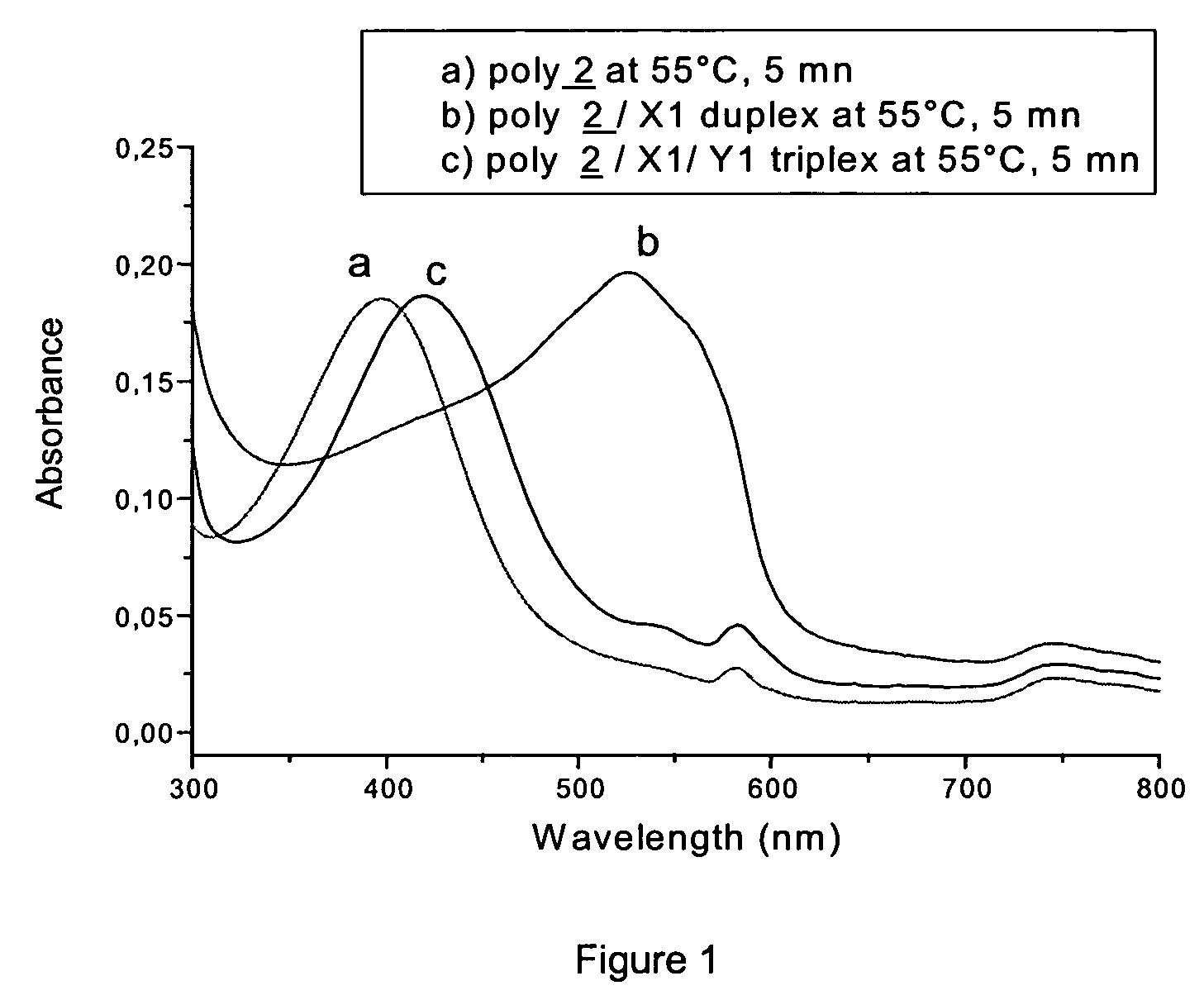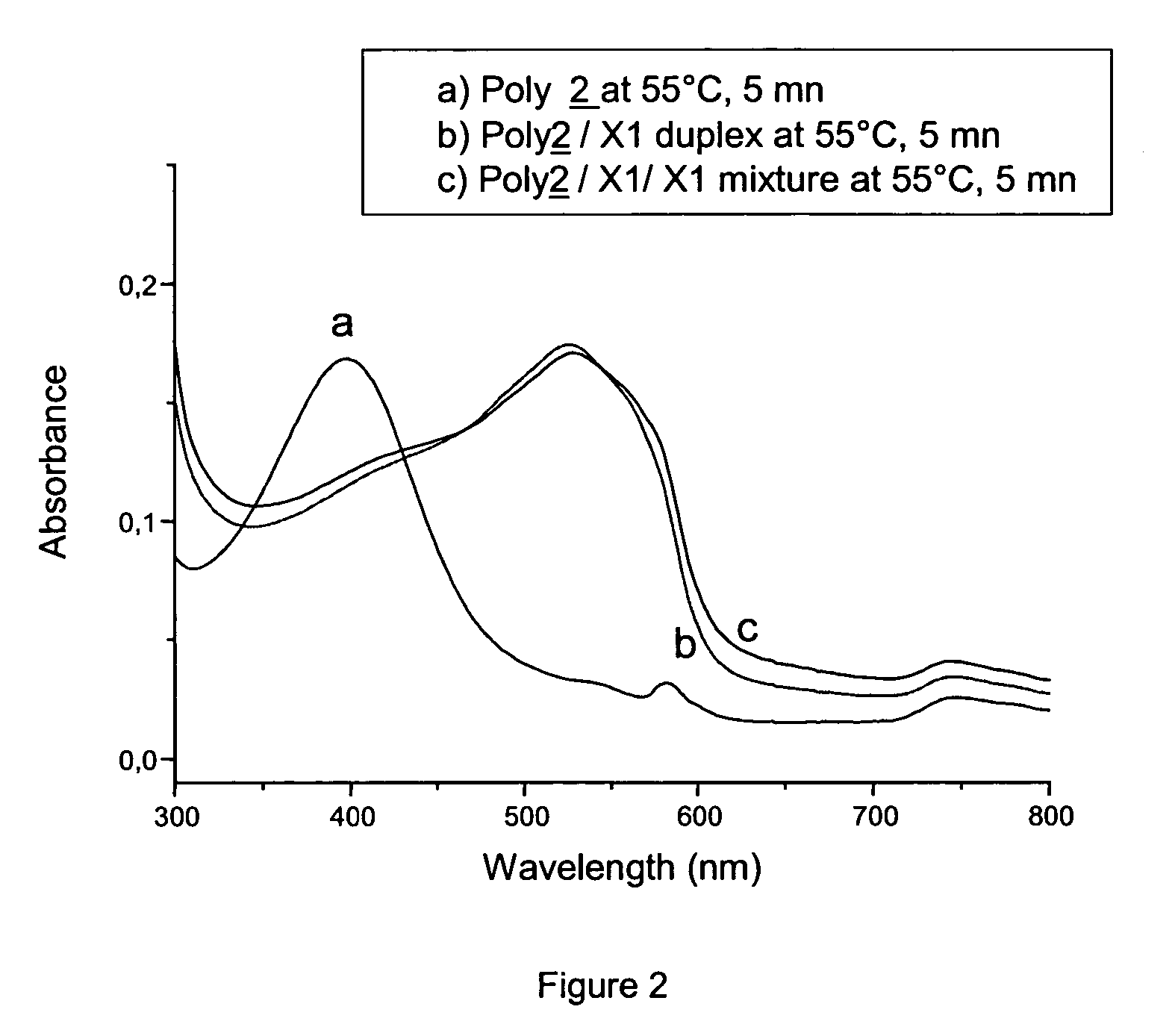Detection of negatively charged polymers using water-soluble, cationic, polythiophene derivatives
- Summary
- Abstract
- Description
- Claims
- Application Information
AI Technical Summary
Benefits of technology
Problems solved by technology
Method used
Image
Examples
example 1
General Procedure for the Aromatic Nucleophilic Substitution on Thiophene; Synthesis of Compound 3
[0096]Sodium hydride (0.4 g, 15 mmol) was added between 0 and 10° C. under nitrogen to a solution of N,N-diethylpropanolamine (2.0 g; 15.2 mmol) in 50 mL of DME, and the resulting mixture stirred at ambient temperature for 20 minutes. 3-Bromo-4-methyl thiophene (2.0 g, 11.3 mmol) dissolved in 20 mL of DME (20 mL) and CuI (1.07 g, 5.65 mmol) were then added to the reaction mixture. The mixture was subsequently stirred overnight at 95° C., while under nitrogen, diluted with methylene chloride and filtered. The organic phase was washed three times with water, dried over MgSO4 and evaporated. The crude product was purified by chromatography on silica gel using CH2Cl2 as the eluent, followed by the use of MeOH.
[0097]Compound 3: Yield 26%; 1H NMR (CDCl3) δ: 1.04 (t, 6H); 1.93 (m, 2H); 2.09 (s, 3H); 2.57 (m, 6H), 3.97 (t, 2H); 6.14 (d, 1H); 6.81 (d, 1H); 13C NMR (CDCl3) δ: 11.69; 12.50; 26.84;...
example 2
General Procedure for Quaternization Reaction: Synthesis of Monomer 1
[0098]1-Bromoethane (6 mL, 80.4 mmol) was added to a solution of compound 3 (0.49, 1.8 mmol) in 60 mL of acetonitrile. The reaction mixture was stirred at 70° C. under nitrogen for 3 days. After evaporation of the acetonitrile, the crude product was crystallized from ethyl acetate as a colorless powder.
[0099]Monomer 1: Yield 100%; m.p. 145–147° C.; 1H NMR (CDCl3) δ: 1.41 (t, 9H); 2.06 (s, 3H); 2.31 (m, 2H); 3.57 (m, 8H), 4.12 (t, 2H); 6.24 (d, 1H); 6.84 (d, 1H); 13C NMR (CDCl3) δ: 7.87; 12.61; 22.55; 53.61; 54.66; 65.80; 97.18; 120.28; 128.26; 154.77.
example 3
Synthesis of Monomer 2
[0100]1-Methyl-imidazole (1.0 mL, 12.3 mmol) was added to a solution of product 4 (0.54 g, 2.46 mmol) dissolved in CH3CN (35 mL). The resulting reaction mixture was stirred at 70° C. for two days. After evaporation of the solvent, the crude product was washed twice with warm ethyl acetate and twice with diethyl ether at room temperature to provide monomer 2 as a pure white solid compound.
[0101]Monomer 2: Yield 88%;. 92–94° C.; 1H NMR (CDCl3) δ: 2.05 (s, 3H); 4.09 (s, 3H); 4.38 (t, 2H); 4.90 (t, 2H), 6.27 (d, 1H); 6.82 (d, 1H); 7.63 (s, 1H); 7.68 (s, 1H); 10.24 (s, 1H); 13C NMR (CDCl3) δ: 12.81; 36.76; 49.36; 68.01; 97.92; 120.68; 123.26; 123.30; 128.35; 137.51; 154.23.
PUM
| Property | Measurement | Unit |
|---|---|---|
| optical path length | aaaaa | aaaaa |
| average molecular weight | aaaaa | aaaaa |
| temperature | aaaaa | aaaaa |
Abstract
Description
Claims
Application Information
 Login to View More
Login to View More - R&D
- Intellectual Property
- Life Sciences
- Materials
- Tech Scout
- Unparalleled Data Quality
- Higher Quality Content
- 60% Fewer Hallucinations
Browse by: Latest US Patents, China's latest patents, Technical Efficacy Thesaurus, Application Domain, Technology Topic, Popular Technical Reports.
© 2025 PatSnap. All rights reserved.Legal|Privacy policy|Modern Slavery Act Transparency Statement|Sitemap|About US| Contact US: help@patsnap.com



